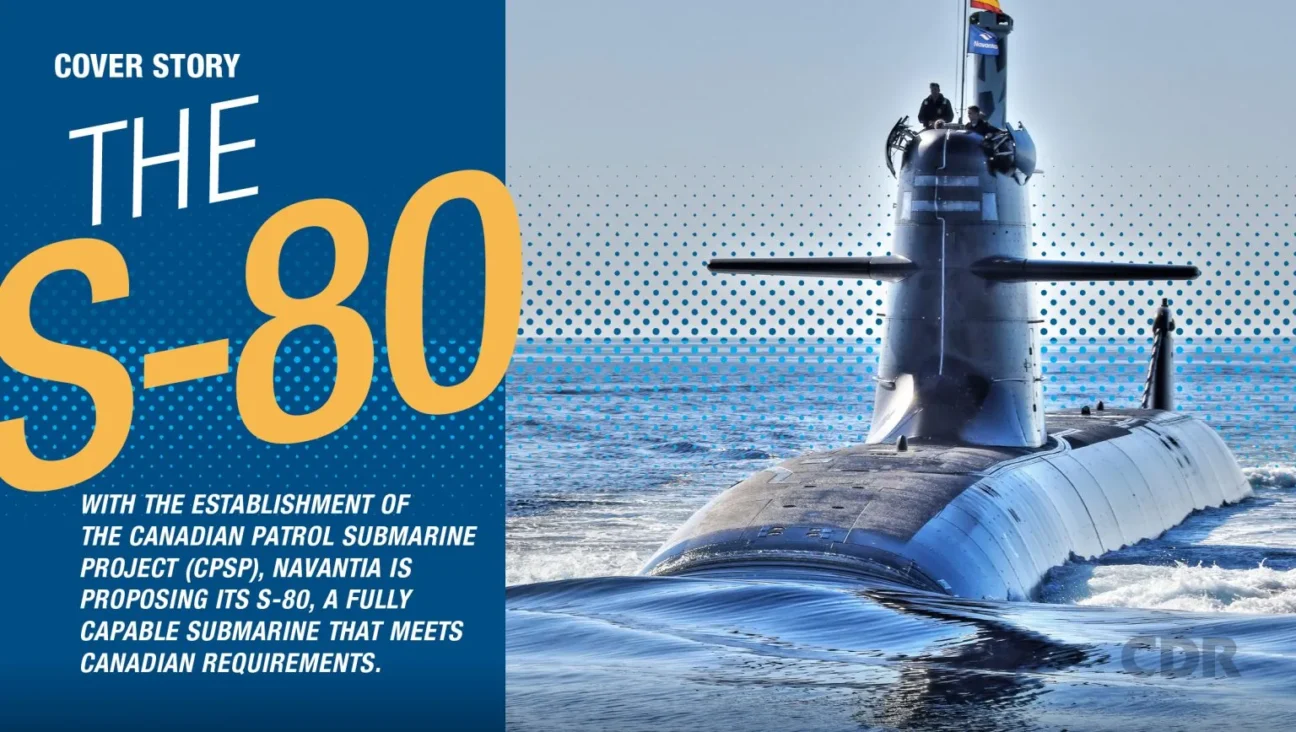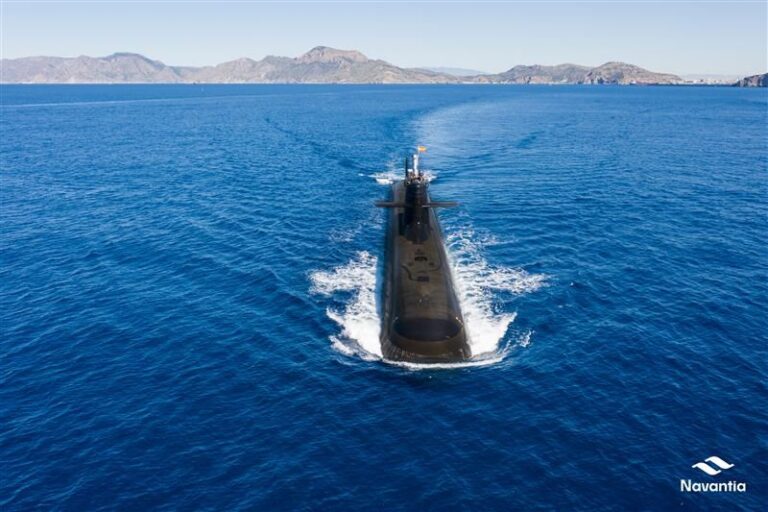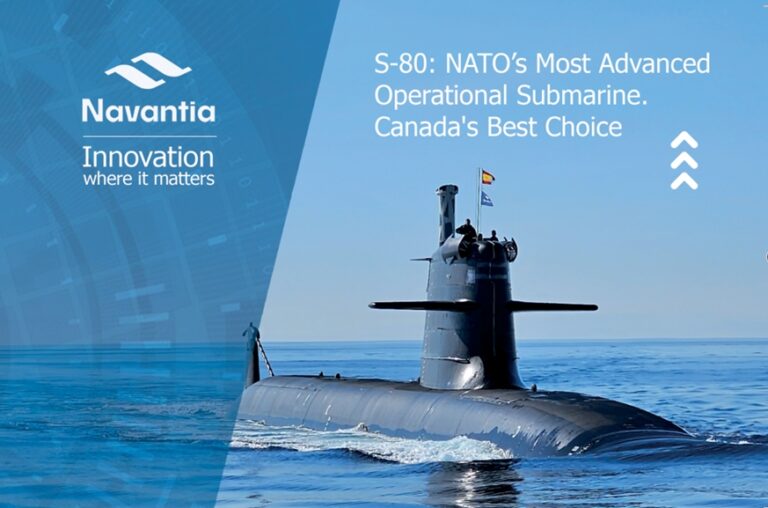With the establishment of the Canadian Patrol Submarine Project now underway, Navantia is proposing its S-80, a fully capable submarine that meets Canadian requirements.
BY JOETEY ATTARIWALA
Navantia is a 100% state-owned company that has a proud 300-year history of designing, building and sustaining technologically advanced ships and submarines. The Spanish company has many pursuits around the globe and is focused on proposing their S-80 class submarine as a solution for the Canadian Patrol Submarine Project (CPSP).
With nearly 4,800 employees worldwide, Navantia has extensive experience exporting ships and submarines. Most recently Navantia was awarded the contract to build the Royal Navy’s future Fleet Solid Support (FSS) ships in Belfast. Recent exports include the Royal Australian Navy’s Hobart Class Anti-Air Warfare destroyer and the Norwegian Navy’s Fridtjof Nansen class frigates. Both of these designs are based on the Spanish Navy F100 frigates which have Lockheed Martin’s AEGIS combat system and SPY radar. Navantia continues to evolve this design and is building the F110 with the AEGIS combat system and the SPY-7 radar, which is the same radar that will be on the Royal Canadian Navy (RCN) River-class Destroyers.
Navantia built the world’s first diesel electric submarine, which was launched in 1888. In the last 100 years, 40 submarines have been built and delivered to the Spanish navy in addition to the Chilean, Malaysian and Indian navies under co-production contracts.
Recognizing the vast area of NATO operations, Navantia, with the support of General Dynamics Electric Boat and the US Navy, designed the S-80 submarine as an oceanic long-range conventional sub (SSK) that would provide NATO a strategic advantage in the anti-submarine warfare domain. With an overall length of 81 meters, a submerged displacement of 2,965 tons, the S-80 can reach over 19 knots of maximum speed and more than 300 meters of Deep Diving Depth (DDD) and can remain submerged for weeks using its third generation Air-Independent Propulsion (AIP) system. This capability is significant because it enables long diving operations to stay under Arctic ice, which the RCN requires. The S-80 can operate for at least 60 days and distances greater than 7,000 nautical miles as per the RCN’s high-level mandatory requirements.
Navantia is known for taking great pride in integrating the “best of class” weapons and sensors, whether they be from European or American suppliers, in addition to providing a comprehensive life cycle support program that includes repairs, modernization and Transfer of Technology services in 20 countries.
“We are very proud of our proven track record and Navantia is equally committed to replicating this same success in Canada with the S-80 submarine,” said Ricardo Dominguez, Chairman of Navantia. “The S-80 program is not a program of the Spanish defence industry but the enterprise of a nation. Navantia and the Spanish Navy work together in the design, construction, and commissioning of the submarines, with a joint Program Office for their maintenance and planning of future upgrades of the submarine where new technologies will be incorporated to the S-80.”
HOW DOES THE S-80 MEET CPSP REQUIREMENTS
According to Navantia, the S-80 meets all of the RCN’s high-level mandatory requirements for the CPSP. The company notes that it is important to recognize that with the tight timelines advertised for the CPSP, the best way to avoid delays and cost overruns in the acquisition of submarines is to acquire a submarine with a sea-proven design already operating in the service of its parent Navy. To this point, the S-81 Isaac Peral has already been delivered to the Spanish Navy and the efficiency gains realized during the production of the next three boats in the class will be advantageous for the RCN. The S-80 class therefore represents a low-risk solution that will be able to meet Canada’s anticipated delivery schedule.
“As a reliable partner with experience exporting to NATO and Five Eyes countries, we are fully committed to ensuring that the S-80 meets all of the operational requirements of the RCN today and, with the growth margins included in its design, for the overall life of the platform,” Dominguez told CDR.
The main advantages of the S-80 in relation to other conventional submarines can be summarized in 5 key points: Sea-proven, long-range, long-diving endurance, reduced crew with a highly automated platform, and 100% NATO supply chain.
“We are confident that the S-80 will meet the challenges of operating in the cold and austere waters of Canada’s Arctic Ocean,” said Dominguez. “The S-80 was designed to perform operations in challenging environmental conditions, and we have already completed several preliminary studies for under-ice operations with very positive results.”
These analyses considered external climate temperatures, external loads from collision due to ice accretion and the needed variable ballast capacity using extreme loading conditions for transits on the Pacific and Atlantic oceans and patrols above 60 degrees latitude.
In addition, the submarine has an excellent depth control from very low speed (<2kn) to maximum speed due to the high vertical stability index and exceptional compromise between stability and maneuverability ensuring the navigation in shallow waters or in difficult areas such as the Bering and David Straits. Hence, the S-80 is able to sail from Esquimalt Harbor, through the Aleutians, the Bering Strait and into the Beaufort Sea for patrol and then return home undetected.
The design of the S-80 submarine follows an Open Systems Architecture using standardized technical regulations which are accepted worldwide by all manufacturing/production systems. This strategy allows low risk replacement of subsystems with COTS subsystems to continuously implement new technologies and systems in the S-80 with very little, if not zero, impact to the platform, as stated by Navantia.

S-80 SPECIFICATIONS
The S-80 Integrated Combat System Core (ICSC) is a highly advanced system developed by Navantia with the support of Lockheed Martin. It is optimized for reduced manning from seven identical Multifunction Consoles (MFCCs) with maximum flexibility in allocation of functionalities. The system also includes a Large Tactical Display (LTD) for the Commanding Officer and two redundant Network and Navigation Server Cabinets (NNSC) to allocate displays, processing resources and interfaces. Depending on the tactical situation, the ICSC can be managed with a minimum of four operators to a maximum of seven in Battle Stations.
The onboard combat system includes Integrated Underwater surveillance capabilities by means of the ICSC Sonar Array Suite (SAS) delivered by Lockheed Martin. The ICSC SAS performs broad and narrow band detection, tracking, Low-Frequency Analysis and Recording (LOFAR) and Demodulation of Envelope Modulation On Noise (DEMON) analysis, and classification of acoustic signals, adaptive noise cancellation, anti-jamming, adaptive beamforming, and more. The system encompasses different sensors for acoustic data gathering at several frequency bands to cope with contacts at short, medium, and long ranges. These sensors include a Bow Cylindrical Array Sonar (CAS) which is behind an innovative Combined Acoustic Window (CAW) of carbon fiber reinforced plastic. A Combined Flank Array Sonar and Passive Ranging Sonar (FAS/PRS) for low and medium frequency range detection on the starboard and port sides. An Intercept Array Sonar (IAS) system providing spatial discrimination, low false alarm detections, and ranging of threats and hostile weapon emissions. A Mine and Obstacle Detection Sonar (MODS) which is designed to provide stand-off detection against minefields and to support navigation. And an Own Noise Monitoring System (ONMS) composed by Hydrophones and Internal Accelerometers for continuous monitoring of the Submarine self-noise behavior, as well as providing support to self-noise cancellation into sonar processing.
In addition, the submarine has a Towed Array Sonar (TAS) which is delivered by the Spanish company SAES. This system is designed with a fully automated deployment and recovery electric winch system fitted in the submarine aft superstructure, and is integrated into the ICSC at any MFCC.
The S-80 submarine is able to deploy different types of NATO weapons. These can be launched from periscope depth to Deep Diving Depth (DDD), with the only limitations being the weapons maximum launching depths.
For Anti-Submarine Warfare (ASW), the S-80 has been designed to integrate a range of torpedoes from the Mk48 that the RCN operates, to the Sea Hake chosen by the Spanish Navy for its submarines. This is possible by integrating Babcock’s Weapon & Handling Discharge System (WHDS) that handles the weapons to 6 Torpedo Launch Tubes.
For Anti-Surface Warfare (ASuW) and coastal targets attack, the S-80 is equipped with the Advanced Harpoon Weapon Control System (AHWCS) to provide control and launch functions of the Block II, and can also operate Block 1, 1B, 1C, 1G, and future compatible variants.
For land-attack, the submarine accommodates the UGM-109-E Block IV All-Up-Round Tomahawk Land Attack Missile. This missile is the encapsulated version of the TLAM for horizontal launch from submarines.
Navantia and the Norwegian company Kongsberg Defense & Aerospace, have been working for the Spanish Navy in a feasibility study to encapsulate and integrate the most advanced Naval Strike Missile into the S-80 submarine, which is gaining interest from several other NATO nations.
For mine-laying there is plenty of flexibility as the S-80 is designed to accommodate all generic design mines.
The S-80 submarine is also equipped with an Acoustic Counter-Measure (ACM) system for deploying anti-torpedo and anti-sonar acoustic countermeasures. These are housed in launchers installed in the outer hull. The system launches three types of countermeasures: anti-torpedo countermeasures, anti-sonar countermeasures, and anti-torpedo training countermeasures. The system provides threat assessments and maneuver recommendations to avoid torpedoes based on a defence plan.
THIRD GENERATION AIP SYSTEM
The S-80 AIP is a Bio-Ethanol Stealth Technology (BEST) system. This BEST-AIP creates the necessary power to charge the batteries and allow the submarine to patrol submerged while maintaining maximum stealth. Developed by Navantia together with global leading companies like Collins Aerospace, this third-generation AIP system replaces the hydrogen storage (present in most of the current AIP submarines) with onboard hydrogen production, producing the needed reforming gas for the fuel cell by means of processing bioethanol. Additionally, the use of bioethanol, instead of a fossil fuel, erases the potential risk of detection by chemical traces using sniffers. At the same time, the use of bioethanol as an energy source minimizes the carbon footprint due to AIP operations and also environmental damage in the unlikely case of an accidental fuel spill.
Due to its high level of automation, the S-80 submarine can be operated by a crew of only 32 members, however, there is additional accommodation to support a crew of 40. These additional bunks can be used for special forces or to train future generations of submariners. Crew members are divided into different cabins each with their own individual bunks.
The S-80 accommodation is designed in compliance with all international standards (NATO, MARPOL, SOLAS, WHO, etc) and with high comfort standards in a modular way so that it can be easily adapted to other crew configurations.
TRAINING ON THE S-80 SUBMARINE
To assist Spanish Navy submariners to transition from their legacy submarines to the new S-80, Navantia’s training solution includes three key simulation tools. The first is a Platform Simulator that allows training of the crew in normal operation and emergency recovery procedures. It is an enclosed cabin with a motion system that represents a 1:1 scale of the equipment located on the port side of the submarine’s command and control room. The second is the Tactical Simulator which is designed to train the crew in a high intensity tactical scenario that may lead to a contact saturation situation which enables the crew to become skilled in discriminating and properly classifying threats or targets. The third is a Maintenance Simulator that provides the crew and maintainers with full virtual reality training, using practical exercise simulators and operational and maintenance e-learning structured at different levels.
The existing proven training solutions using S-80 simulators could be used to avoid a gap in the readiness of RCN submariners, and accelerate operational on-site training, and that would facilitate Canadian acceptance sea trials of new boats and save costs.
According to Spanish Navy Director of Engineering and Shipbuilding, Vice-Admiral Nicolás Lapique, “The Spanish Navy fully supports Navantia in their proposal of submarines to Canada or other nations. This support would start with realistic at-sea training serials before the delivery of the first Canadian Patrol Submarine and continue during the maintenance of the submarines once delivered.”
Together with the Spanish Navy, Navantia has created a new In-Service Support (ISS) scenario. A solution is based on technical ISS management whose main objectives are to ensure safe navigation and optimize costs, all while achieving maximum operational availability.
“This model is transferable to Canada with high-level industrial cooperation between Navantia and Canadian defence industry. Both sides would profit from the Spanish Navy acting as the ‘Parent Navy’ and Navantia as the Technical Design Authority. Canada will benefit from a submarine with 100% NATO supply chain with NATO cataloguing,” said Lapique. This is not only relevant for construction of the vessels but also In-Service Support as the submarine’s supply chain for major systems and equipment is already in place, with many companies having a presence in North America, especially those for weapons and sensors, such as Lockheed Martin, Collins Aerospace, Boeing, L3Harris and Babcock.
S-80 – A PROVEN SOLUTION FOR CANADA
Navantia is confident that the S-80 represents an exceptionally low risk solution that will not only meet all of the Royal Canadian Navy’s operational requirements, but will also fit the aggressive timelines required. In addition, Navantia looks forward to enabling Canadian industry participation, not only in the design and build of the submarine, but for the life of the boat with its tried and trusted In-Service Support model. As a trusted strategic partner with the US Navy and Lockheed Martin, as well as other Five Eyes Navies and many European weapons and sensor providers, Navantia looks forward to leveraging these capabilities to enable the Royal Canadian Navy to deploy a fleet of submarines that will meet the strategic needs of the nation.



